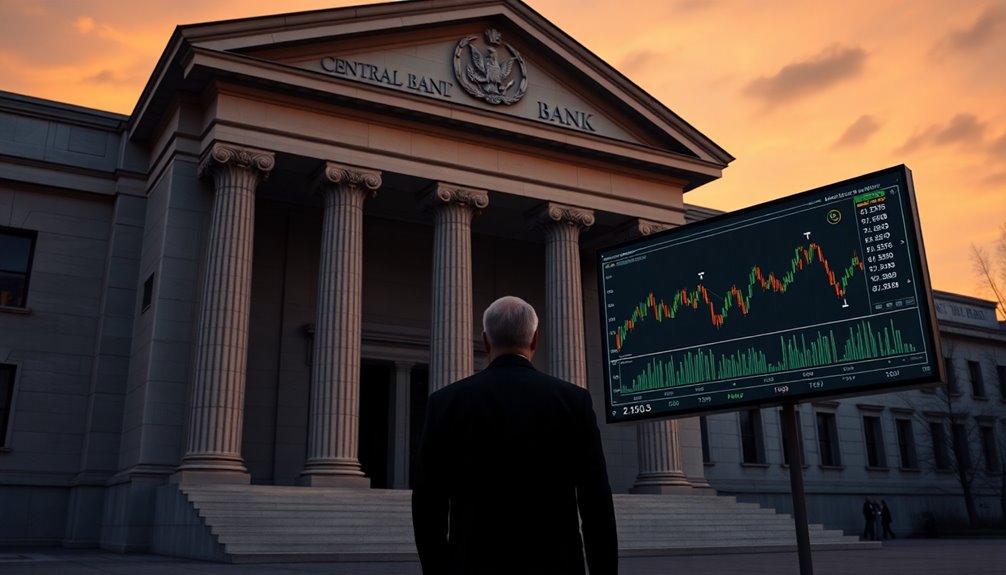The Federal Reserve has declared that central banks can't hold Bitcoin as reserves due to legal restrictions. Fed Chair Powell emphasized there are no plans to change these regulations without Congressional approval. This decision reflects concerns about Bitcoin's volatility and the need for regulatory oversight in the crypto market. Some countries have outright banned cryptocurrencies, while others explore Central Bank Digital Currencies (CBDCs) as safer alternatives. So, while central banks steer clear of Bitcoin, the landscape of digital currency continues to evolve. If you want to explore the implications of this decision further, more insights await you.
Key Takeaways
- The Federal Reserve confirms central banks cannot hold Bitcoin due to existing legal prohibitions.
- Fed Chair Powell states there are no plans to alter Bitcoin regulations.
- Congressional approval is necessary for any future changes regarding Bitcoin holdings.
- Regulatory uncertainty and skepticism from the Fed contribute to Bitcoin's market volatility.
- The U.S. government currently holds over 200,000 BTC, reflecting significant crypto influence.
Central Banks' Bitcoin Restrictions

Although many people are excited about the potential of cryptocurrencies, central banks face significant restrictions when it comes to owning Bitcoin. Current laws prohibit them from holding Bitcoin, creating a legal barrier that complicates their engagement with digital currencies. Regulatory ambiguity further complicates the situation, as cryptocurrencies often don't fit into existing frameworks. SEC Chairman Gary Gensler's call for greater oversight highlights the perceived risks, likening the sector to the "Wild West." Additionally, some countries have outright banned cryptocurrencies, exemplified by India and Nigeria's restrictions. These challenges keep central banks from exploring Bitcoin's benefits, reinforcing their reliance on traditional fiat systems while navigating a complex landscape of regulatory and legal limitations. Furthermore, as of January 2024, 130 countries are exploring central bank digital currencies (CBDCs) to compete with cryptocurrencies.
New Fed Policy Announcement

As the landscape of cryptocurrencies evolves, the Federal Reserve has made it clear that it won't be adding Bitcoin to its portfolio anytime soon. Current laws prohibit the Fed from holding Bitcoin, and Fed Chair Jerome Powell has reaffirmed this stance, emphasizing that there are no plans to change these regulations. The Fed prioritizes the health and stability of the banking sector, focusing on how cryptocurrencies interact with traditional finance. Any potential shift towards holding Bitcoin would require Congressional approval, a prospect the Fed seems unlikely to support. Following Powell's comments, Bitcoin's value experienced a decline, reinforcing the market's sensitivity to the Fed's policies on cryptocurrencies. The Fed remains skeptical about digital assets while allowing the private sector to innovate. The institution's reluctance aligns with the increasing interest from corporations and institutions in maintaining Strategic Bitcoin Reserves (SBR).
Cryptocurrency Volatility Impact

When navigating the world of cryptocurrencies, you'll quickly notice that Bitcoin's volatility can be influenced by a range of factors.
Regulatory uncertainty, like China's 2021 ban on Bitcoin, can cause drastic price drops. You'll also see that retail investor behavior plays a significant role; their sentiment and speculative trading often drive price swings.
Major global events can shift market perceptions, contributing to instability. Additionally, the nominal price illusion affects low-priced cryptocurrencies, leading to irrational trading behaviors. The lack of institutional safeguards makes Bitcoin vulnerable to abrupt regulatory changes, which can lead to increased volatility. Moreover, mining difficulty adjustments can also impact market supply and affect price stability.
While institutional participation could stabilize the market, short-term speculation often exacerbates volatility.
Ultimately, economic variables like interest rates and liquidity challenges further complicate Bitcoin's price dynamics, making it a rollercoaster ride for any investor.
Digital Asset Integration Challenges

The complexities of cryptocurrency volatility naturally lead to discussions about the challenges of integrating digital assets into the broader financial system. One major hurdle is the divergent regulatory environments across countries, creating fragmentation and uncertainty. Without consistent international and domestic regulations, the acceptability of digital assets remains at risk. Additionally, you'll encounter technological issues, such as fragmented platforms and interoperability challenges that complicate seamless transactions. Swift has enhanced global interoperability with its infrastructure over the past 50 years, which is crucial for addressing these challenges. To navigate these challenges effectively, it is essential to understand regulatory compliance in different jurisdictions. Privacy and security concerns also loom large, with risks of data centralization and potential state surveillance. Lastly, the impact on economic stability is significant; banks may face liquidity shortfalls if a considerable amount of deposits shifts to central bank digital currencies (CBDCs), disrupting lending operations and essential financial services.
Regulatory Responses to Market Pressure

While navigating the turbulent waters of cryptocurrency, regulatory bodies are under pressure to adapt their frameworks to ensure stability and safety.
The Federal Reserve maintains its prohibition on holding Bitcoin, focusing instead on safeguarding consumers and the banking sector. They're not seeking legal changes but provide guidance on managing crypto activities. Interestingly, the US government holds over 200,000 BTC valued at over $20 billion, which underscores the growing influence of digital currencies.
The OCC takes a more permissive stance, allowing banks to engage with cryptocurrencies if they exercise prudent risk management.
Meanwhile, the FDIC emphasizes supervision through a structured plan to
Central Bank Digital Currency Trends

As regulators grapple with the implications of cryptocurrencies, attention is shifting towards Central Bank Digital Currencies (CBDCs) as a potential solution.
Currently, no major economy has fully launched a CBDC, but China is leading with its e-CNY pilot. Several countries, like the Bahamas and Nigeria, have implemented their CBDCs, while Europe is preparing for the digital euro and digital pound. Despite global engagement from 134 jurisdictions, challenges remain, such as security issues, infrastructure risks, and public awareness. Current CBDC adoption remains slow due to challenges like public awareness and trust, making it crucial for central banks to consider diversifying their portfolios to mitigate risks.
Effective design and deployment strategies, including regulatory frameworks and user education, are crucial for successful adoption. Ultimately, CBDCs aim to enhance financial inclusion and maintain monetary sovereignty in an increasingly digital economy.
Frequently Asked Questions
What Are the Main Reasons for the Fed's Bitcoin Reserve Ban?
The main reasons for the Fed's Bitcoin reserve ban revolve around security concerns, regulatory frameworks, and strategic purpose.
You'll notice significant risks like fraud and volatility that could threaten central banks. There's also a lack of legal clarity, making operations difficult.
Moreover, Bitcoin doesn't provide cash flows or serve as a reliable hedge against inflation, which diminishes its relevance.
Public perception and political challenges further complicate any potential adoption of Bitcoin reserves.
How Will This Policy Affect Individual Investors in Bitcoin?
This policy can create a ripple effect for you as an individual investor in Bitcoin.
With increased regulatory scrutiny and potential restrictions, you might see heightened market volatility, making it harder to predict price movements.
The lack of institutional support could shake your confidence, leading to speculation rather than stability.
Ultimately, you may face greater risks and challenges in navigating an already uncertain market landscape, which could impact your investment strategies significantly.
Are Other Cryptocurrencies Also Restricted for Central Banks?
Did you know that over 60% of countries are exploring cryptocurrency regulations?
Many central banks face restrictions not just on Bitcoin but also on other cryptocurrencies. These regulations vary widely, with some nations outright banning certain digital assets while others impose stringent rules on their use.
If you're investing, it's crucial to stay informed about your country's stance, as these restrictions can significantly impact the market and your investment decisions.
What Are the Potential Implications for Global Financial Stability?
If central banks consider holding cryptocurrencies, you might face significant implications for global financial stability.
Increased market volatility could lead to sudden value drops, amplifying systemic risks. Regulatory uncertainty complicates asset management, adding operational challenges.
These factors could hinder effective monetary policy, facilitate capital outflows, and create currency mismatches.
Ultimately, the interconnectedness of digital assets with traditional finance could destabilize the broader economy, impacting everyone involved.
How Might This Decision Impact Future Cryptocurrency Regulations?
Imagine a ship navigating through rocky waters; this decision could steer future cryptocurrency regulations toward clearer paths.
You might see global bodies uniting to establish consistent standards, helping central banks and financial institutions align.
With regulatory clarity, you'll find it easier to integrate cryptocurrencies into traditional finance.
Expect innovation in regulatory frameworks to address challenges, while protecting stakeholders, as the industry grapples with the ever-evolving landscape of digital assets.
Conclusion
In light of the Fed's new policy, central banks are steering clear of Bitcoin reserves, much like sailors avoiding stormy seas. With the volatility of cryptocurrencies posing risks, integrating digital assets into traditional banking remains a challenge. As regulatory responses evolve, it's crucial for central banks to navigate these turbulent waters carefully. Embracing Central Bank Digital Currencies might be their safest bet, offering stability while still keeping pace with the changing financial landscape.









